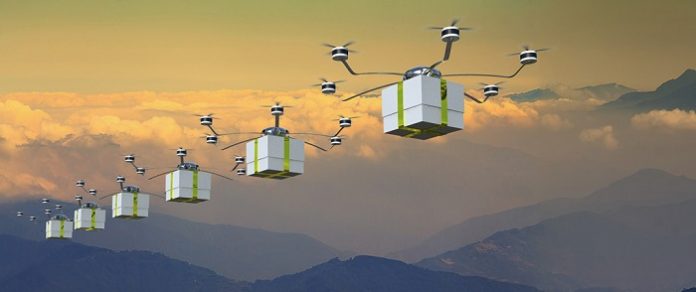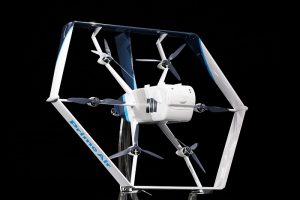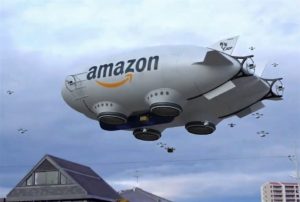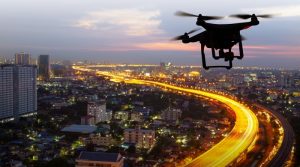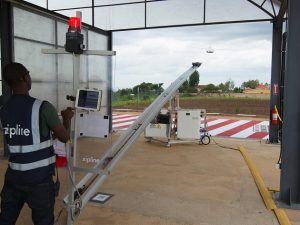Santa Claus flies around on Christmas Eve, landing on rooftops to deliver packages to good girls and boys. Soon, drones may fly around on Christmas Eve, landing on front yards to deliver packages to parents who forgot to buy presents. “Unmanned Aerial Vehicles”, more popularly known as Drones will literally be your help from the above in the very near future.
Drones were being used for commercial and security purposes already worldwide. But the COVID-19 slam dunk brought the whole world to its knees last year, however in every catastrophic time, the technology always finds a way to pave its path to advancements and serve the world. The idea which was just a topic for an armchair talk in the not-so-distant past has now become a sector with prosperous potentials.
Drone Deliveries are the next big thing and it has been a very long-awaited dream for so many people to get their supplies and packages via the route of skies where there would be no traffic congestions and red lights. One can imagine the amount of time and cost of logistics and transportation that will be saved once this idea will get its due spot in the play.
Amazon Prime Air
Getting impatient for your amazon package to arrive will pretty soon be a thing of the past. Well, Amazon has invested billions into delivery drones that can deliver packages in 30 minutes or less. Amazon Prime Air could save the company approximately 44 billion dollars per year in shipping cost, and a drone could permanently $127 billion worth of human effort. The e-commerce giant has spent more than $100 billion on research and development in the last decade, and much of that has been used to develop AI technologies like autonomous drones. One day, human delivery drivers could get obsolete.
Jeff Bezos is on the cusp of revolutionizing amazon’s delivery system. Amazon Prime Air is the company’s delivery program. It might be expensive now but in the long run, it might be able to save online retailers billions resulting in the shipping costs of the packages dramatically. Bezos first introduced this plan for drone delivery in 2013, and amazon finally received FAA approval for its drone fleet last year. And now, amazon can begin testing customer deliveries in the US.
Things have gone a lot more smoothly for amazon in the UK. The e-commerce giant completed its first successful Prime Air delivery way back in 2016. The delivery of an Amazon Fire TV and a bag of popcorn took only 13 minutes to deliver via drone. Since then, Amazon is in the process of perfecting its drones.
Futuristic Drones
The first drone prototypes were big and bulky, but the most recent design is more sleek and futuristic. Thanks to its hexagonal shape, the drone takes off vertically like a helicopter but as soon as it is in the air it transits into flight mode. The panels that protect the rooters act as wings in flight mode, and each drone has a total of six rotors.
Two double blade rotors and four triple-blade rotors. State-of-the-art visual, thermal, and ultrasonic sensors allow the drones to safely navigate through the skies and avoid obstacles in the air and on the ground.
The drones also have the ability to detect when a person is too close, and it won’t take off until the customer has retrieved the package. The drones can even detect the obstacles like close lines. These drones can travel up to 15 miles, however as of now, they are only capable of delivering packages that weigh under 5 pounds or less.
But that’s not a design flaw completely, as Amazon says that more than 75 to 95% of their packages are under the weight limit anyway.
Billions Saved
It costs approximately 10 cents for amazon to deliver a 4.4 pounds package over a distance of 6 miles via drone. On the other hand, delivering a package via ground is far more expensive.
It costs Amazon between $2 and $8 to deliver a package from one of its warehouses to a customer’s doorstep via its last-mile delivery program. Just think of the amount of money that could be saved if amazon doesn’t have to pay its workers and spend money on the fuel.
The company has spent $37.9 billion on shipping in 2019 and the 2020 cost was significantly higher. Drones would almost completely eliminate those costs, and the saving would be astronomical and amazon plans to pass those saving to customers, eventually.
Amazon is not the only company developing delivery drones.
There is a lot of competition in the air:
| Alphabet’s WING.
|
Unites Parcel Service
|
UPS Airlines
|
Walmart
|
Flytrex
|
Wingcopter
|
Zipline
|
DHL Helicopter
|
Drone Delivery Systems Can Face Heavy Turbulence in Indian Skies.
India seems to keep the use of Unmanned Arial Vehicle famously known as drones, under their thumb. The Civil Aviation Ministry, in a notification on Unmanned Aircraft System (UAS) Rules, 2021, has spelled out the norms for operating UAS or drones. Importantly, it lists the quantum of punishment for unauthorized flying and manufacturing drones which range from Rs 25,000 to Rs 5 lakh.
Unlike other countries, flying drones in India has been sort of taboo, mostly due to unclear government policies as well as concerns around privacy. While flying non-military unmanned aerial vehicles or drones is legal in most other countries and the market size is estimated to be over $100 billion globally this year, India’s restrictive policies have meant that the lucrative segment has largely stayed dormant.
Things only took a turn with the recent pandemic outbreak when law enforcement agencies deployed drones for surveillance, announcements, and monitoring situations remotely.
Hyperlocal delivery brands like Zomato, Swiggy, and Dunzo have already planned for the test flights of drones to deliver their packages this year. But the new laws by the Civil Aviation Ministry of India have set the record straight. And before you ask, let us tell you that the new rules under the law have kicked out the possibility of receiving your packages from the sky, as it is not allowed to use drones as a delivery system in India by the law.
The rules, which were finalized after about ten months of consultations, say drones weighing more than 250 grams can only be flown by a remote pilot with permission from the Directorate General of Civil Aviation (DGCA) for every flight. Flying a drone by a person who is not a licensed remote pilot will also be an offense.
As per the new drone laws, they cannot be flown within five kilometers of international airports at Mumbai, Delhi, Chennai, Kolkata, Bengaluru, and Hyderabad, and at a distance of three kilometers from any civil, private, or defense airport.
A penalty of Rs 50,000 will be imposed on individuals who operate a drone over a no-operation area. Individuals importing, manufacturing, trading, owning, or operating drones must be citizens of India and above 18 years of age.
Typically these fancy flights will be used only for photography, security, and various information gathering purposes.
The use of drones in safety, law and order, disaster management, and surveillance operations will be done based on the situation.
Every Silver Lining.
The horrors of COVID-19 have prompted many countries to devise new and emerging technologies to fight the pandemic. One such latest example of technology serving mankind is happening in Ghana. This month, COVID-19 vaccines were delivered by drone for the first time in the West African nation, allowing the medicine to reach remote areas underserved by traditional logistics. Whilst the ever-rising privacy concerns with drone flight on one side, there is an extension to the ease for humans themselves.
And while drones by them selves certainly can’t solve all the challenges associated with delivery, they can certainly be part of a bigger solution.
selves certainly can’t solve all the challenges associated with delivery, they can certainly be part of a bigger solution.
By Mayank Vashisht | Technology Journalist | ELE Times



